A designer's universe: Vitra opens first Alexander Girard retrospective
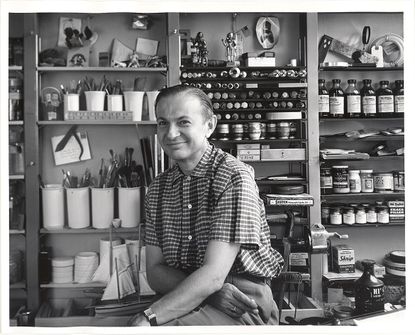
Until now, Alexander Girard's work has been relatively unknown – certainly when compared to the fame of his contemporaries Charles and Ray Eames, Isamu Noguchi and George Nelson, say – but that is soon to change as the American interior and fabric designer's oeuvre is celebrated at the Vitra Design Museum.
'Alexander Girard: A Designer's Universe' is the latest exhibition to take up residence in in the Frank Gehry-designed building, filling its curved walls and multiple spaces with the vibrance, colour and sense of joy that characterised Girard's work.
Curated by Jochen Eisenbrand and designed by London-based studio Raw Edges, the display chronicles the life and work of Girard, starting with his early beginnings in architecture; to his bright and bold textiles for fabric giant Herman Miller; his spirited, ‘living’ interiors and restaurant concepts; and his extensive folk art collection.
‘We normally showcase around 300 items in an exhibition like this,’ explains Eisenbrand, ‘but here have over 700.’
Taking on the challenge of presenting so much at once in a calm and collected manner were Shay Alkalay and Yael Mer of Raw Edges. As Eisenbrand explains, it was no simple feat: ‘Girard did many exhibitions himself and was a master of displaying things, so it was a high level that one had to match.’ But match it they did.
The 3D mural, the banners of hanging fabric, a series of alcoves and the idea of a ‘room within a room’ – all classic Girard motifs – are all seamlessly incorporated. As are colour, pattern and ornament, the three tenets of Girard’s practice.
'There is so much going on, but the connections are what were really important for us [to show],' explains Alkalay. 'You can see how [his folk art collection, for example] would inspire one project and then developed into other ideas and come back again and again.'
‘It is a dense amount of information,’ says Girard's grandson Kory of the undertaking, ‘but it doesn’t feel "packed" or look "crammed" because there are so many layers.’
Dense is putting it lightly though. Girard was nothing if not prolific, and his attention to detail was beyond outstanding. The phrase ‘ahead of his time’ may as well have been created for him, too. He created ‘themed restaurants’ long before they were in vogue, he brought colour and style to the skies through his work with Braniff Airlines, and made the home a joyous place at a time when design was all about reductionism and rationality. He celebrated what we now refer to as the ‘maker’s culture’ and ‘post-industrial processes’ long before the terms were coined or debates had. He sought a humanist agenda, celebrating a universal common bond that still holds true today. And perhaps it is because of that foresight, that vision, that this exhibition is so rewarding.
In another first for Girard, a 500-page catalogue published to accompany the exhibition provides the first scholarly examination of his work. All in all, it is a fitting celebration for a man who restored what classical modernism had rejected in design and combined ostensible antagonists (craftsmanship and industry, pop culture and high art etc) with both ease and flair.
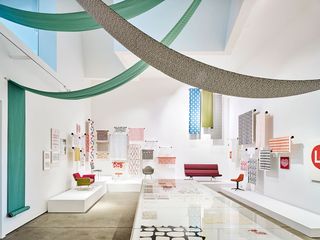
Curated by Jochen Eisenbrand and designed by London-based studio Raw Edges, the display chronicles the life and work of Girard, starting with his early beginnings in architecture; to his bright and bold textiles for fabric giant Herman Miller (pictured); his spirited, ‘living’ interiors and restaurant concepts; and his extensive folk art collection. Courtesy of the Vitra Design Museum

The Miller House, pictured, was one of Girard's most important interior design projects and offers exemplary evidence of his passion for detail and the quality of his projects. Pictured: Miller House, Columbus, Indiana, 1953–1957. Courtesy of The Library of Congress
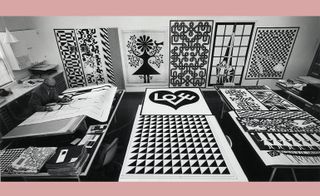
Girard's vast estate – entrusted to the Vitra Design Museum in 1996 – compromises more than 5,000 plans, drawings and sketches, as well as hundreds of textile patterns and around 7,000 photographs. Pictured: Girard designing his Environmental Enrichment Panels for Herman Miller, c.1971. Courtesy Alexander Girard Estate/Vitra Design Museum

A trained architect, Girard liked to use archways and create 'a space within a space' in many of his interior design projects, as it added a sense of 'mystery and magic to the ordinary', explains his granddaughter Aleishall, two concepts masterfully employed by Raw Edges in the Vitra Museum exhibition (pictured)
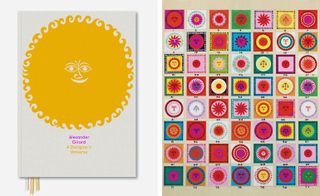
Pictured left: providing the first scholarly examination of Girard's work, a 500-page catalogue has been published to accompany the exhibition. Right: matchbox designs for famous NY restaurant La Fonda.
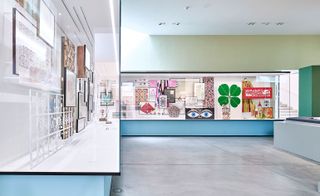
Inspired by the 3D mural Girard created for John Deere, Raw Edges designed this space to showcase the scale and scope of Girard's oeuvre. Courtesy of the Vitra Design Museum

Raw Edges cleverly used colour to separate each space; not in a garrish, attention-seeking way, but rather as a deliberate, mood-setting method celebrating the ethos of Girard's own love of bright and bold shades. Courtesy of the Vitra Design Museum

Fabrics, interiors and exhibitions were not the full extent of Girard's talents. In 1965 he was also responsible for the complete corporate redesign of Braniff International Airways, from the aeroplanes to the air hostesses' uniforms, to the tickets and everything inbetween.
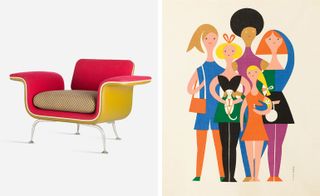
Girard made the home a joyous place at a time when design was all about reductionism and rationality. Pictured left: 'Armchair No. 66310', 1967, series production by Herman Miller Furniture Co. Photography: Jürgen Hans. Courtesy Vitra Design Museum. Right: 'Girls, Environmental Enrichment Panel # 3001', for Herman Miller, 1971. Courtesy Alexander Girard Estate/Vitra Design Museum
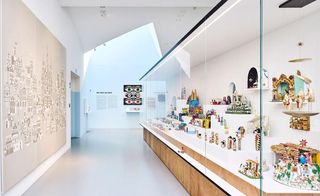
Upstairs, a large vitrine holds a sample of Girard’s extensive folk art collection which so inspired and informed his work. Following in Girard’s footsteps, Raw Edges opted to forgo labels, allowing the items to speak for themselves and appeal to a global audience. Photography: Mark Niedermann. Courtesy of the Vitra Design Museum

’The connections are what were really important for us [to show],’ explains Raw Edges’ Shay Alkalay, ’you can see how [his folk art collection, for example] would inspire one project and then developed into other ideas and come back again and again’. Pictured left: poster for ’The Nativity’ exhibition of folk art, Nelson Gallery of Art, 1962. Right: ’Daisy Face, Environmental Enrichment Panel #3036’, for Herman Miller, 1971.
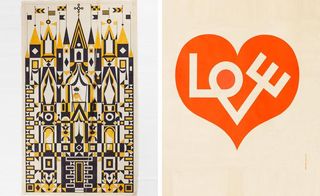
Above all, Girard’s work persued a humanist agenda, celebrating a universal language and common bond that still holds true today. Pictured left: design drawing for textile panel. Photography: Andreas Sütterlin. Right: ’Love Heart, Environmental Enrichment Panel #3017’, for Herman Miller, 1971. Both courtesy of Alexander Girard Estate/Vitra Design Museum

Girard’s archiving systems were as detailed and meticulous as the projects themselves, an even greater achievement when one considers that most of his work was achieved without an office or permanent staff. Pictured: storage boxes arranged and labeled by Girard. Photography: Andreas Sütterlin.
INFORMATION
’Alexander Girard: A Designer’s Universe’ is on view until 29 January 2017. Catalogue from €69.90. For more information, visit the Vitra Design Museum’s website
ADDRESS
Vitra Design Museum
Charles-Eames-Straße 2
79576 Weil am Rhein
Wallpaper* Newsletter
Receive our daily digest of inspiration, escapism and design stories from around the world direct to your inbox
-
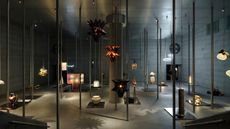 Loewe’s Jonathan Anderson drafts artists to create 24 extraordinary lamps at Milan Design Week 2024
Loewe’s Jonathan Anderson drafts artists to create 24 extraordinary lamps at Milan Design Week 2024Loewe creative director Jonathan Anderson commissioned international artists and artisans to explore ‘illumination within the house’ with a series of lamps and lighting installations, shown at a group exhibition at Milan Design Week 2024
By Scarlett Conlon Published
-
 What are polynucleotides? Trying the skin injectable made from salmon sperm
What are polynucleotides? Trying the skin injectable made from salmon spermPolynucleotides are the latest in skin injectables, containing DNA derived from the gonads of salmon. Wallpaper* Beauty & Grooming Editor Hannah Tindle tries them to discover exactly how they work
By Hannah Tindle Published
-
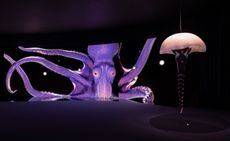 Josèfa Ntjam on her surreal utopias in Venice
Josèfa Ntjam on her surreal utopias in VeniceArtist Josèfa Ntjam and LAS Art Foundation bring other worlds to life with ‘swell of spæc(i)es’ at Palazzina Canonica during the Venice Biennale 2024
By Hannah Silver Published
-
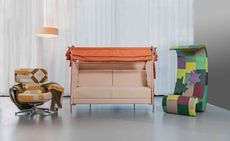 Glasgow School of Art students give new life to CitizenM lobby furniture
Glasgow School of Art students give new life to CitizenM lobby furnitureCoinciding with COP26, CitizenM partners with The Glasgow School of Art to showcase iconic Vitra furniture pieces repurposed by interior design students in collaboration with Bute Fabrics
By Rosa Bertoli Last updated
-
 Munch Museum’s furniture is inspired by the artist’s colours
Munch Museum’s furniture is inspired by the artist’s coloursSustainability-focused Norwegian furniture company Vestre has created furniture designed by Andreas Engesvik and Jonas Stokke for the new Munch Museum in Oslo
By Rosa Bertoli Last updated
-
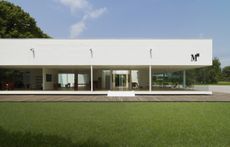 Molteni Museum opens in Ron Gilad’s glass cube
Molteni Museum opens in Ron Gilad’s glass cubeRon Gilad brings fresh perspective to the Molteni Museum’s Glass Cube in Giussano. Former Wallpaper* Milan editor and current Triennale Design Museum director Marco Sammicheli spoke to Ron Gilad and Giulia Molteni for our Summer 2020 issue to find out about the museum’s plans
By Marco Sammicheli Last updated
-
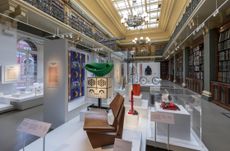 New V&A gallery explores contemporary history through design
New V&A gallery explores contemporary history through design‘Design: 1900 – Now’, a permanent gallery at the V&A in London, opens with a thematic display charting the 20th and 21st centuries’ most relevant social movements. We talk to curators Corinna Gardner and Johanna Agerman Ross to discover highlights from the collection
By Rosa Bertoli Last updated
-
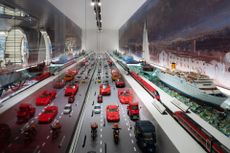 All aboard! Immersive design museum on a cruise ship celebrates Italian icons
All aboard! Immersive design museum on a cruise ship celebrates Italian iconsThe mobile museum is housed inside one of Italian company Costa Smeralda's cruiseship, featuring a selection of design icons and a futuristic set by Tihany Design
By Rosa Bertoli Last updated
-
 At MAD Museum in Brussels, Belgian design and a WallpaperSTORE* pop-up
At MAD Museum in Brussels, Belgian design and a WallpaperSTORE* pop-upBy Rosa Bertoli Last updated
-
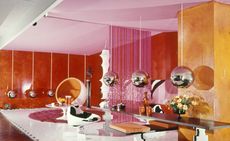 Pleasure island: the decadent interiors of Australia’s first lady of modernist design
Pleasure island: the decadent interiors of Australia’s first lady of modernist designBy Adam Štěch Last updated
-
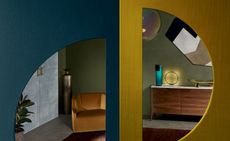 Bow belles: stay ahead of the curve with sensual velvets and geometric arcs
Bow belles: stay ahead of the curve with sensual velvets and geometric arcsBy Rosa Bertoli Last updated